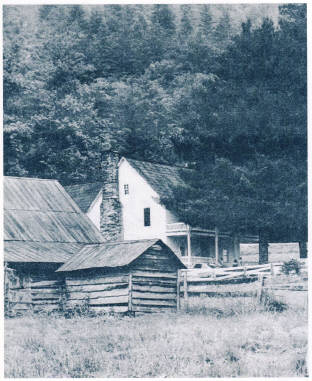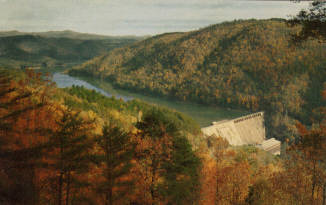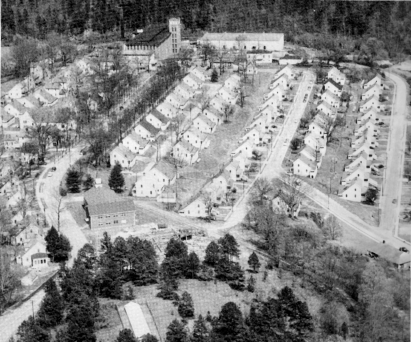
Russell Farm
The Russell Farm often served as overnight lodging for weary travelers between Highlands, NC and Walhalla, SC. As many as 80 visitors are said to have stayed there at one time, including a future president, Woodrow Wilson. Many travelers, weary of the hot summers of South Carolina, would vacation in Highlands. Their train ride ended in Walhalla and from there, they continued by stage coach for two more days. The first part of the house was built in 1867 by Ganaway Russell. The story goes that he helped to drive a herd of cattle to Sacramento, CA. He sewed his payment, gold coins, into his vest to avoid robbers and used this money to purchase the farm when he returned. His wife, Jane Nicholson Russell, managed the “inn,” raised 15 children, served as a midwife to the community and even ran a post office out of the main house. Fire destroyed the Russell House and several outbuildings in 1988. The farmstead is listed on the National Register of Historic Places.
Salem
Salem was first chartered on September 9, 1907. The town limits were one square mile. Salem was equipped with a church, a school, six stores, a photo studio, postal service and six sawmills within three miles. There was even talk of a railroad through the young town.
As time progressed, Salem’s lumber industry decreased which left farming to be the area’s main source of income. With poor crops due to flood and the threat of the boll weevil, the town of Salem found it more and more difficult to operate.
Finally, in 1916, town officials decided to surrender the town charter. In order to do so, a two-thirds majority vote was needed from the town. The vote, held on October 19, 1915, saw a turnout of 24 men: 17 voted to surrender the charter while 7 voted in favor of keeping Salem incorporated. With only 59 percent, short of the two-thirds majority needed, Salem remained a town. However, the mayor sent the results to the Secretary of State three months later. On January 19, 1916, the charter for the town of Salem was canceled, despite the lacking majority vote.
Tugalo and Yonah Dams

By 1917, the Georgia railway and Power Company had developed four dams and power plants along a 20-mile stretch of the Tallulah River in Northeast Georgia. Two remained to be built: Tugalo and Yonah. The first of these was the Tugalo, located just below the confluence of the Tallulah and Chattooga Rivers, which formed the Tugalo River. Construction of the dam and power plant began in 1917, was discontinued during the World War, resumed in 1922 and was completed in 1924. The dam is 155 feet high and 840 feet wide, with the resulting impounded body of water named the Tugalo Lake. Located three miles down river from the Tugalo Dam and power plant, Yonah Dam, along with its power plant and resulting lake were completed in 1925. Both hydro plants remain in operation today, as part of Georgia Power, a Southern Company.
Note: Two spellings of the name Tugalo are commonly used: “Tugalo” and “Tugaloo.” Tugalo was the spelling used by the builders in 1917.
DAR School
At the 1914 Congress of the Daughters of the American Revolution, a $500 challenge was presented to “establish a school for needy Revolutionary Soldier descendants, preferably in the South.” However, the Executive Board voted against national support.
So it was in November of 1914 that the South Carolina DAR proposed to their State Conference to “establish a school in the ‘dark corner’ of South carolina, remote but accesible where the need was greatest.”
The site ultimately selected seemed to fit the 1914 criteria. It was home to many Revolutionary War descendant families. For the most part, the large families remained self-reliant but virtually uneducated. Transportation was dependent on horse and wagons, with barter and trade determining the financial status of the inhabitants.
Land proposed for the new school had once been owned by General Andrew Pickens. In the famous “Ring Fight” of 1776, Pickens and his men fought Cherokees nearby. Years later, Pickens returned and built his final home.
In 1916, the 100 acre site, valued at $12.50 per acres, was offered for the proposed school. Walhalla businessmen pledged $1,000 and local men promised free labor. A list of fourteen “Advantages and Reasons for the Location” accompanied the offer.
The project was adopted, with a target date of being open by November 1, 1917, a goal that was pushed back due to the advent of the Great War. DAR chapters across the country supported the effort. Local chapters, especially those in Walhalla and Clemson played vital roles. By the fall of 1918, the first building was under construction. Donated labor, materials and furniture, as well as articles obtained with Octagon soap coupons helped, but funds ran out. Generous donors underwrote areas of the building so that even though the inner walls and full furnishings were not in place, the Tamassee Industrial School, for girls only, opened on February 24, 1919.
Newry
In 1893, William Ashmead Courtenay of Charleston, established the first textile mill in Oconee County along the Little River. He named this location “Newry” after his ancestral home in Ireland.
On April 21, 1893, Courtenay and his associates received a charter from the South Carolina secretary of state “to establish a factory in Oconee County for the manufacturing, spinning, dying, printing, and selling of all cotton and woolen goods.”
To his stockholders, Courtenay wrote, “It was in a sparsely settled and unfrequented corner of the county; labor had to be brought there, shelters built for them; in fact all the primitive conditions of the distant border had to be dealth with, machinery for brick making and other purposes had to be transported from distant points, one and a half miles of railroad must be graded and built…”
At about the same time as the mill, the company office and store were built. Mr. Courtenay soon built a two-story mansion, which he called “Innisfallen” after the family estate in Ireland.
On June 14, 1894, water first turned one of the mill power wheels. The mill was in full operation by the end of that year. The plant was originally operated by hydro power, but c. 1905, steam engines and boilers increased production.
In 1890, workers in South Carolina textile mills earned an average weekly wage of $5.17. Nearly all employees of textile mills in Upstate South Carolina were white and had been either poor farmers from nearby or from the mountains. Child labor was not uncommon in any southern textile mill. Laws came in 1903 that prohibited children under the age of 12 from working in mills. That age was changed to 14 in 1917 and by 1919, only six percent of workers in the Carolinas were under the age of 16.

The workers of Courtenay Manufacturing Company had access to housing, a church, school, store, boarding house, doctor, cotton gin, jail and a piped sewage system.
When construction was complete, there were about 115 houses, most of which were “saltbox” style, with two-stories and a slanting rear roof. Most were designed to house two families.
By 1903, the mill was running 635 looms. Workers filled many different jobs including picker, opener and slasher in the carding room; spooler and doffer in the spinning room; battery filler, drawing-in, fixer and warp tender in the weaving room and stitcher, inspector and folder in the finishing room.
Problems came to the mill village with major floods in 1903 and 1915, which flooded the lower floor of the mill, as well as an outbreak of smallpox in 1910 and an influenza epidemic in 1918.

